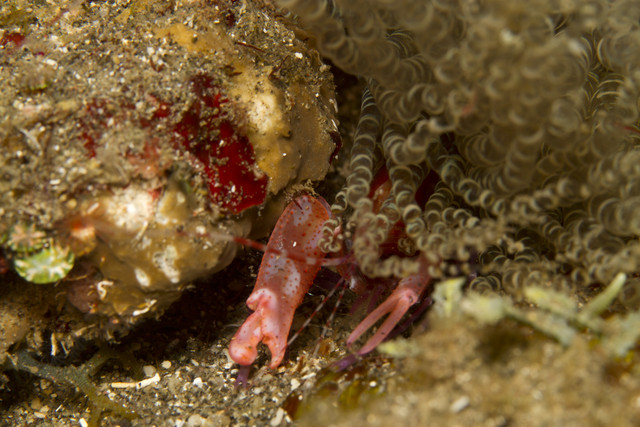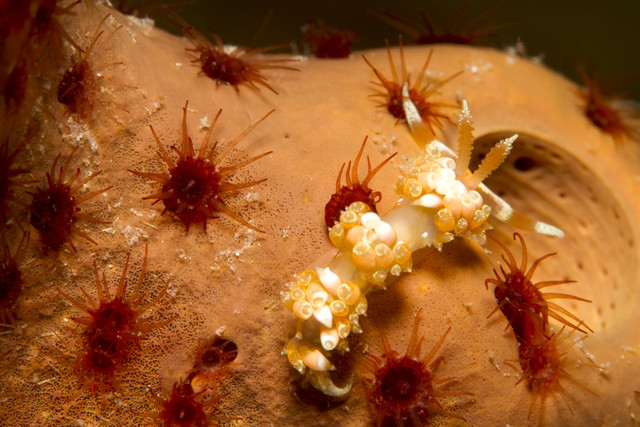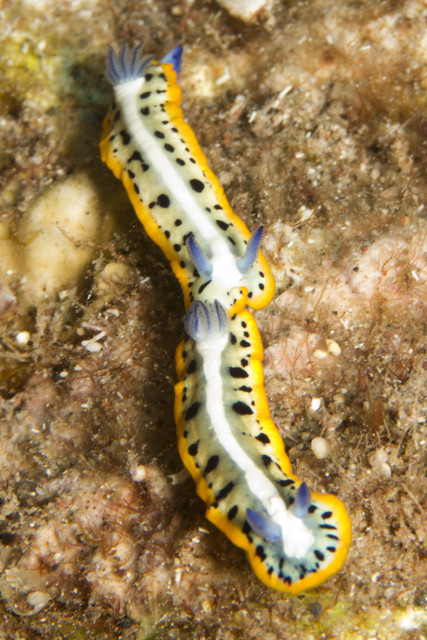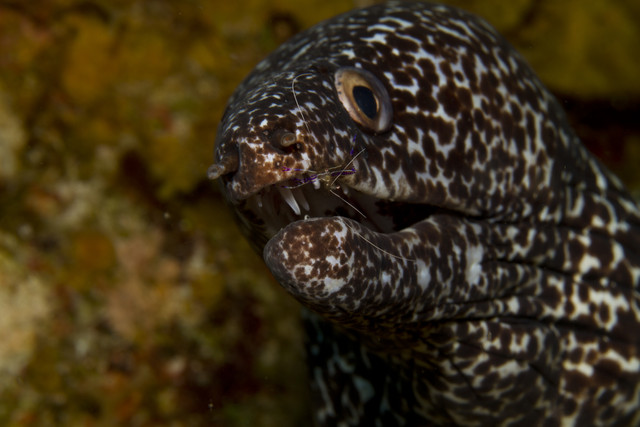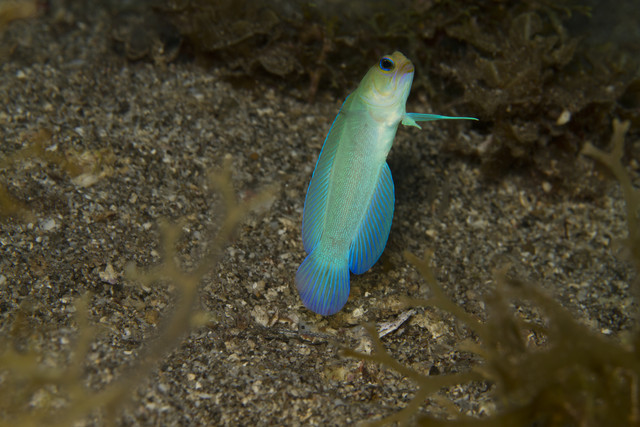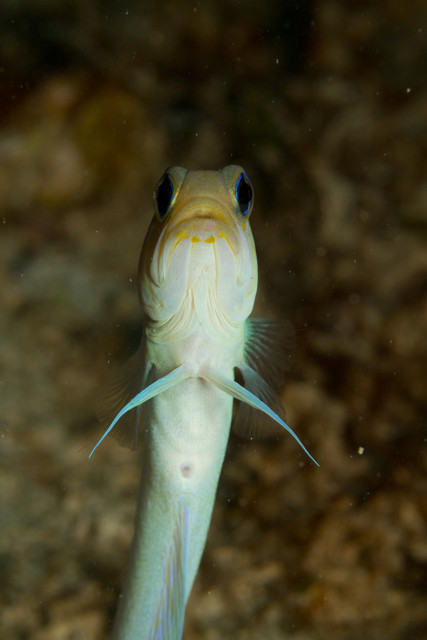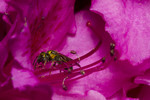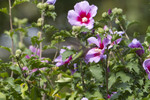Caribbean Explorer: Red Snapping Shrimp
ktuli — Sun, 10/30/2011 - 20:34
Today's subject is an interesting one... It is called a Snapping or Pistol Shrimp (Alpheus armatus). As you can see in the shot below, they have that one larger claw - but I'll let the video explain why that is cool. These guys were somewhat easy to find on the reef because they usually were found hiding underneath the Corkscrew Anemone (Bartholomea annulata). Unfortunately, that also made them difficult to photograph as they usually were partially obscured, and there was plenty of other things for the AF system to pick up.
Technical Data: Canon EOS 7D, Canon EF 100mm f/2.8L Macro IS USM, 1/120th sec at f/16. Image Stabilization on. ISO 100. Ikelite Housing and Port with Ikelite 161 Strobe in TTL Mode. Raw conversion in Photoshop CS5.
I didn't take the following video (though I certainly wish I worked for the BBC), but take a minute or so and see just how impressive that tiny little claw is...
Pretty obvious where the name comes from, huh?
- Bill
Poll: Caribbean Explorer: Redlip Blenny
ktuli — Thu, 10/27/2011 - 17:53
This isn't the first (nor will it be the last) blenny I'll share here, but this particular species works well for a little voting. There are two main color phases with this species - the all dark reddish-brown ones and the bi-color grey body with reddish head.
The species is a Redlip Blenny (Ophioblennius macclurei). This funny looking little fish are small (around 2-4 inches) and like most blennies stay near holes or burrows that they use to hide in. As you approach, they quickly retreat into the recesses of the reef and will slowly return if you remain still long enough. Because of this, they were somewhat challenging to photograph, and I had to approach them slowly to get a decent shot.
Since I have managed to get good photos of both color varieties, we'll do a slightly different poll today. Instead of picking which photo you think looks better, just pick which fish color phase you like better!
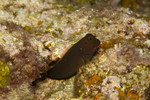 |
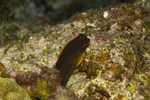 |
 |
 |
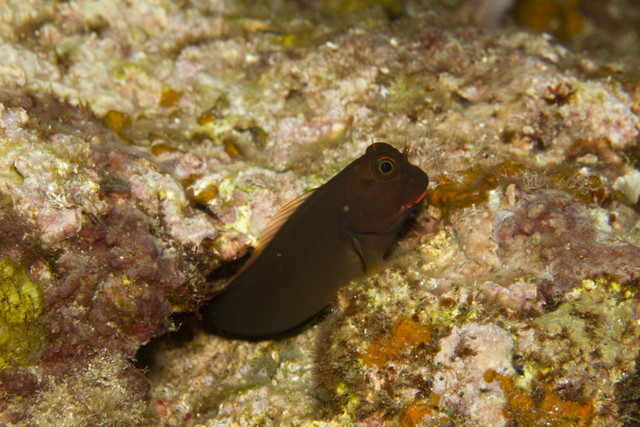
|
|||
Technical Data: Canon EOS 7D, Canon EF 100mm f/2.8L Macro IS USM, 1/120th sec at f/16. Image Stabilization on. ISO 100. Ikelite Housing and Port with Ikelite 161 Strobe in TTL Mode. Raw conversion in Photoshop CS5.
So hopefully by now you know the drill. Place your vote, then leave a comment to let me know why you chose the one you did.
- Bill
Caribbean Explorer: Hermit Crab Assortment
ktuli — Wed, 10/26/2011 - 19:44
Title pretty much says it all... these guys are pretty hard to identify, and I think some of them aren't even in the book. Most of them appear to be Red Reef Hermits (Paguristes cadenati), but the other three I can't tell for sure.
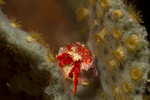 |
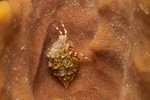 |
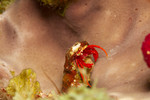 |
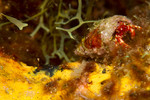 |
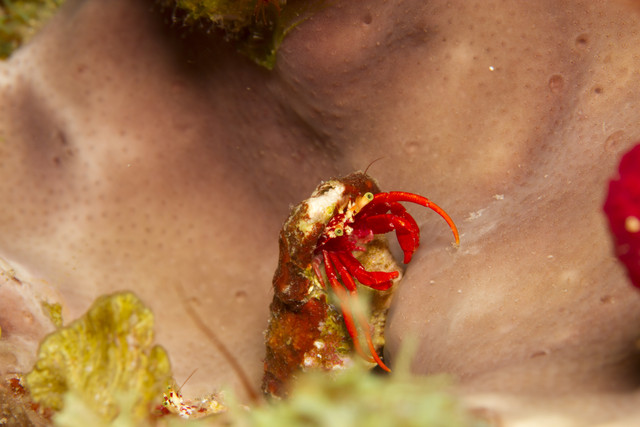
|
|||
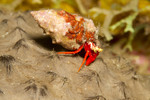 |
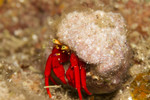 |
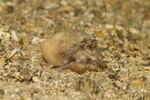 |
Technical Data: Canon EOS 7D, Canon EF 100mm f/2.8L Macro IS USM, 1/120th sec at f/16. Image Stabilization on. ISO 100. Ikelite Housing and Port with Ikelite 161 Strobe in TTL Mode. Raw conversion in Photoshop CS5.
Enjoy!
- Bill
Caribbean Explorer: Long-Horn Nudibranch
ktuli — Tue, 10/25/2011 - 21:55
More nudibranchs today... this is a Long-Horn Nudibranch (Austraeolis catina).
Technical Data: Canon EOS 7D, Canon EF 100mm f/2.8L Macro IS USM, 1/120th sec at f/16. Image Stabilization on. ISO 200. Ikelite Housing and Port with Ikelite 161 Strobe in TTL Mode. Raw conversion in Photoshop CS5.
- Bill
Caribbean Explorer: Another Caribbean Reef Octopus
ktuli — Mon, 10/24/2011 - 18:03
Alright - just stopping by to share another shot of a Caribbean Reef Octopus - this time showing off a bit of how they are able to change their skin texture to mimic their environment - in this case some sargassum
Technical Data: Canon EOS 7D, Canon EF 100mm f/2.8L Macro IS USM, 1/120th sec at f/16. Image Stabilization on. ISO 100. Ikelite Housing and Port with Ikelite 161 Strobe in TTL Mode. Raw conversion in Photoshop CS5.
Don't worry - there are plenty more good octopus shots to share, so this won't be the last...
- Bill
Caribbean Explorer: Purple-Crowned Sea Goddess Nudibranchs
ktuli — Sat, 10/22/2011 - 19:46
Well - if they're to be found, you had to know I'd get some photos of nudibranchs. While there wasn't as wide of an assortment as Wakatobi, I did end up seeing at least four species. However, without a doubt, this pair was the highlight of the trip in terms of nudis.
This is a pair of Purple-Crowned Sea Goddess (Chromodoris or Mexichromis kempfi).
At first, I thought this behavior may have been mating, but as it turns out, nudibranchs have their sexual organs on the right side of their head, so they would have had to have been side by side, not single file like this. It is possible that this trailing behavior is a prelude to mating, but it still seems uncommon (though, I've been able to find several other photos of this species exhibiting this trailing behavior).
None-the-less, I was told by our dive masters on the trip that this species of nudibranch is pretty rare to see in that area. Ad considering I was the one to find them (actually, only Anya and I got to see them during the dive as we were at the end of the group, and everyone else had moved on).
Technical Data: Canon EOS 7D, Canon EF 100mm f/2.8L Macro IS USM, 1/120th sec at f/16. Image Stabilization on. ISO 100. Ikelite Housing and Port with Ikelite 161 Strobe in TTL Mode. Raw conversion and cropped in Photoshop CS5.
The original shot (mouseover to see) was very nicely done, but I also felt it would benefit from a nice tight crop to fille the frame with just the nudis.
I'll be sharing some of the others both of these two and of the other species we saw soon.
- Bill
Cris Rose Ruckus Robots (part 1)
ktuli — Thu, 10/20/2011 - 17:58
So the other night, my father-in-law asked if I would take some photos of some of his resin sculpture toy art robots. These are small, but very interesting sculptures designed by London based artist Cris Rose.
Well, we battled fading light conditions and a massive swarm of the most blood thirsty mosquitoes I have ever seen, but we came away with a handful of really great and fun photos.
This one in particular is my favorite of the set. It has several issues with it that I'll discuss shortly, but I really loved the dramatic lighting on this one. At this stage, we had just moved the robots under this stone bench next to the pond (obviously the source of all of the mosquitoes) - my father-in-law was helping by positioning the flash, but in this particular shot, I hadn't really told him where to point the flash, and we just kind of lucked out with this strong side-lighting.
The dark shadows - especially in the archway - really give a feeling of mystery. The texture of the stone bench archway and the pebbles helps to produce a nice scene and play with one's perspective on size of the scene.
I am a little disappointed in my selection of aperture which produced a little less depth of field than I think the scene could use. Additionally, I need to crop down slightly to eliminate the shadow in the top right corner (which is produced by the edge of the seat on the bench). And the large pebble directly in front of the larger robot is distracting... and for that matter, so is the smaller robot. The positioning, and the fact that the smaller robot has fell over makes it just look out of place.
I'll have to go reshoot this for sure...
Technical Data: Canon EOS 7D, Tokina AT-X M35 Pro DX AF 35mm f/2.8 Macro 1:1, 1/100 sec at f/4.5. Canon Speedlight 580EX II flash in auto mode and wireless control. ISO 100. RAW processing in Adobe Camera Raw.
I took several other shots of these robots, including some using TTV which I will share soon (but after I get through some more of the dive photos).
- Bill
Caribbean Explorer: Bearded Fireworm
ktuli — Wed, 10/19/2011 - 19:42
Today's subject was so abundant on the reefs on this trip, that I literally got tired of trying to take photos of them. Their bristle-like hairs really played havoc on the camera's focus and exposure systems. They also never stopped moving - though they didn't swim around quickly like a fish, they did have a continuous methodical movement that made them a bit difficult to work with. I managed plenty of good shots of them none-the-less, and by the end of the week, I would just swim right on past them unless it was a really interesting individual. This one in particular was sitting on a bright orange sponge that matched its color pretty well, and I was able to time a shot pretty well to get it crawling over the edge of the sponge and in a nice composition.
They are called Bearded Fireworms (Hermodice carunculata) and get their name from those tufts of white bristles all along their length. The bristles are supposedly like getting bits of fiberglass under your skin - painful, irritating, and itchy. I saw ones as small as a half inch, all the way up to about eight inches; they also ranged in color from this bright reddish orange shown here, to yellow, red, green, brown, and even white.
This particular specimen I liked because of the nice combination of orange on orange, and then add in that the white bristles made it look like it was glowing or other-worldly, and I couldn't pass up taking this shot.
Technical Data: Canon EOS 7D, Canon EF 100mm f/2.8L Macro IS USM, 1/120th sec at f/16. Image Stabilization on. ISO 100. Ikelite Housing and Port with Ikelite 161 Strobe in TTL Mode. Raw conversion in Photoshop CS5.
If you're getting tired of the dive photos, tune in tomorrow as I'm going to take a little break and share some shots I took of my father-in-law's small robot sculptures.
- Bill
Caribbean Explorer: Reef Dentistry
ktuli — Tue, 10/18/2011 - 19:12
You know - when you get something stuck in your teeth, it is so easy to just grab a toothpick and take care of that. But what about when you're 40ft underwater? And what about if you're an eel, and you have no arms?
Well, there's a solution for that too...
Just make a visit to your friendly neighborhood cleaning station. This particular one is operated by a Pederson's Cleaner Shrimp (Periclimenes pedersoni).
This Spotted Moray Eel (Gymnothorax moringa) apparently needed to have something removed from those large fangs, and didn't mind posing for me while doing so.
Mouseover the image for a cropped version showing the Pederson's Shrimp at work.
Technical Data: Canon EOS 7D, Canon EF 100mm f/2.8L Macro IS USM, 1/120th sec at f/16. Image Stabilization on. ISO 100. Ikelite Housing and Port with Ikelite 161 Strobe in TTL Mode. Raw conversion in Photoshop CS5.
I have plenty more shots of eels and shrimp separately, but capturing this kind of reef behavior is always a special treat.
- Bill
Caribbean Explorer: Yellowhead Jawfish
ktuli — Mon, 10/17/2011 - 19:39
Ok - don't feel much like typing, so here's a double dose of a Yellowhead Jawfish (Opistognathus aurifrons).
Technical Data: Canon EOS 7D, Canon EF 100mm f/2.8L Macro IS USM, 1/120th sec at f/16. Image Stabilization on. ISO 100. Ikelite Housing and Port with Ikelite 161 Strobe in TTL Mode. Raw conversion in Photoshop CS5.
Technical Data: Canon EOS 7D, Canon EF 100mm f/2.8L Macro IS USM, 1/120th sec at f/16. Image Stabilization on. ISO 100. Ikelite Housing and Port with Ikelite 161 Strobe in TTL Mode. Raw conversion in Photoshop CS5.
Enjoy!
- Bill

